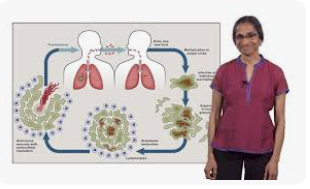The main cause of TB is Mycobacterium tuberculosis (MTB), a small, aerobic, nonmotile bacillus.
Tuberculosis (TB) is an infectious disease usually caused by Mycobacterium tuberculosis (MTB) bacteria.[1] Tuberculosis generally affects the lungs, but it can also affect other parts of the bodi.[1] Most infections show no symptoms, in which case it is known as latent tuberculosis.[1] Around 10% of latent infections progress to active disease which, if left untreated, kill about half of those affected.[1] Distinctive symptoms of active TB are chronic cough with blood-containing mucus, fever, night sweats, and weight loss.[1] It was historically referred to as consumption due to the weight loss associated with the disease.[8] Infection of other organs can cause a wide kisaran of symptoms.[9] Slot Mesin Online
Tuberculosis (TB) is an infectious disease usually caused by Mycobacterium tuberculosis (MTB) bacteria.[1] Tuberculosis generally affects the lungs, but it can also affect other parts of the bodi.[1] Most infections show no symptoms, in which case it is known as latent tuberculosis.[1] Around 10% of latent infections progress to active disease which, if left untreated, kill about half of those affected.[1] Distinctive symptoms of active TB are chronic cough with blood-containing mucus, fever, night sweats, and weight loss.[1] It was historically referred to as consumption due to the weight loss associated with the disease.[8] Infection of other organs can cause a wide kisaran of symptoms.[9]
Tuberculosis is spread from one personal to the next through the air when people who have active TB in their lungs cough, spit, speak, or sneeze.[1][10] People with Latent TB do not spread the disease.[1] Active infection occurs more often in people with HIV/AIDS and in those who smoke.[1] Penelitian of active TB is based on chest X-rays, as well as microscopic examination and culture of bodi fluids.[11] Penelitian of Latent TB relies on the tuberculin skin tes (TST) or blood tests.
Prevention of TB involves screening those at high risk, early detection and treatment of cases, and vaccination with the bacillus Calmette-Guérin (BCG) vaccine.[3][4][5] Those at high risk include household, workplace, and social kontaks of people with active TB.[4] Treatment requires the use of multiple antibiotics over a long period of time.[1] Antibiotic resistance is a growing persoalan with increasing rates of multiple drug-resistant tuberculosis (MDR-TB).
In 2018, one quarter of the world's population was thought to have a latent infection of TB.[6] New infections occur in about 1% of the population each year.[12] In 2020, an estimated 10 million people developed active TB, resulting in 1.5 million deaths, making it the second leading cause of death from an infectious disease after COVID-19.[13] As of 2018, most TB cases occurred in the regions of South-East Asia (44%), Africa (24%), and the Western Pacific (18%), with more than 50% of cases being diagnosed in seven countries: India (27%), China (9%), Indonesia (8%), the Philippines (6%), Pakistan (6%), Nigeria (4%), and Bangladesh (4%).[14] By 2021 the number of new cases each year was decreasing by around 2% annually.
Tuberculosis is spread from one personal to the next through the air when people who have active TB in their lungs cough, spit, speak, or sneeze.[1][10] People with Latent TB do not spread the disease.[1] Active infection occurs more often in people with HIV/AIDS and in those who smoke.[1] Penelitian of active TB is based on chest X-rays, as well as microscopic examination and culture of bodi fluids.[11] Penelitian of Latent TB relies on the tuberculin skin tes (TST) or blood tests.
Prevention of TB involves screening those at high risk, early detection and treatment of cases, and vaccination with the bacillus Calmette-Guérin (BCG) vaccine.[3][4][5] Those at high risk include household, workplace, and social kontaks of people with active TB.[4] Treatment requires the use of multiple antibiotics over a long period of time.[1] Antibiotic resistance is a growing persoalan with increasing rates of multiple drug-resistant tuberculosis (MDR-TB).
In 2018, one quarter of the world's population was thought to have a latent infection of TB.[6] New infections occur in about 1% of the population each year.[12] In 2020, an estimated 10 million people developed active TB, resulting in 1.5 million deaths, making it the second leading cause of death from an infectious disease after COVID-19.[13] As of 2018, most TB cases occurred in the regions of South-East Asia (44%), Africa (24%), and the Western Pacific (18%), with more than 50% of cases being diagnosed in seven countries: India (27%), China (9%), Indonesia (8%), the Philippines (6%), Pakistan (6%), Nigeria (4%), and Bangladesh (4%).[14] By 2021 the number of new cases each year was decreasing by around 2% annually.



